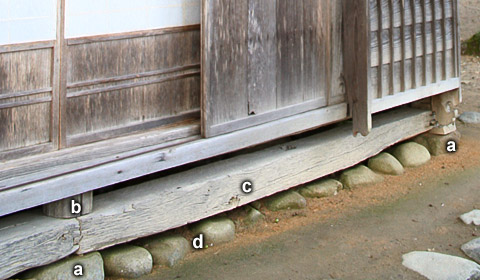|
||
 |
||
2@Rough stones laid in a line either above or below ground level between pillar base stones *soseki bΞ. These provide a strong foundation for the next layer of carefully fashioned stones placed on top of them. The sill *jifuku n’ is positioned on this, and each end is inserted into the pillar base stone. The timber component *dodai yδ is laid on the sill with each end inserted into the pillars.

3@A large irregularly shaped stone upon which a circular base stone is laid. This base stone has a mortise *hozo-ana ΩΌ cut into the center to receive the tenon *hozo ΩΌ which is cut into the bottom of a pillar. Two rectangular stone projections cut out of the hazama-ishi extend at right angles in the direction of the walls to be erected.
@
(C)2001 Japanese Architecture and Art Net Users System.@No reproduction or republication without written permission.
fΪΜeLXgEΚ^ECXgΘΗASΔΜRecΜ³f‘»E]ΪπΦΆά·B

